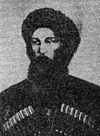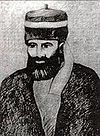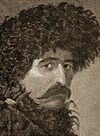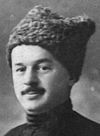- Chechen people
-
Chechens (Noxçiy) Total population 1,500,000 worldwide (2009) Regions with significant populations  Russia
Russia(including Chechnya) 1,360,253[1]  Chechnya
Chechnya1,031,647[1]  Ingushetia
Ingushetia95,403[1]  Dagestan
Dagestan87,867[1]  Rostov Oblast
Rostov Oblast15,469[1]  Moscow
Moscow14,465[1]  Stavropol Krai
Stavropol Krai13,208[1]  Volgograd Oblast
Volgograd Oblast12,256[1]  Tyumen Oblast
Tyumen Oblast10,623[1]  Astrakhan Oblast
Astrakhan Oblast10,019[1]  Europe
Europe100,000 (not including Russian Federation)[2]  Turkey
Turkey70,000[3]  Kazakhstan
Kazakhstan35,000[1]  Jordan
Jordan10,000[1]  Azerbaijan
Azerbaijan5,000[2]  Egypt
Egypt5,000[2]  Syria
Syria4,000[2]  Georgia
Georgia10,000 (including 9,000 Kist people)  Iraq
Iraq2,500[4]  Iran
IranN/A (estimates from 2,000-10,000)  United States
United States500  Canada
Canada100
All data from 2009Languages Religion Predominantly Sunni Islam (of Shafi`i school)
Related ethnic groups Chechens (Chechen: Hохчи Noxçi; old-Chechen: Nakhchu, Nakhchij, Nakhch Qam) constitute the largest native ethnic group originating in the North Caucasus region. They refer to themselves as Noxçi (singular Noxçi or Noxço). Also known as Sadiks (Isod people), Gargareans, Malkhs (Malkhoi). The isolated mountain terrain of the Caucasus and the strategic value outsiders have placed on the areas settled by Chechens has contributed much to the Chechen community ethos and helped shape national character. Chechen and Ingush peoples are collectively known as the Vainakh.[5]
Contents
Origins of the word Chechen
The term "Chechen" is ultimately believed to derive from the Iranian name for the Noxçi and it first occurs in Arabic sources from the 8th century. According to popular tradition, the Russian term "Chechen" comes from the name of the village of Chechen-Aul, where the Chechens defeated Russian soldiers in 1732. The word "Chechen", however, occurs in Russian sources as early as 1692 and the Russians probably derived it from the Kabardian "Shashan".[6]
Geography and diaspora
The Chechen people are mainly inhabitants of Chechnya, Russian Federation. There are also significant Chechen populations in other subdivisions of Russia (especially in Dagestan, Ingushetia and Moscow). A smaller numbers of Chechens are widely scattered in Siberia and the Russian Far East.
Outside Russia, countries with significant Chechen diaspora populations are Turkey, Kazakhstan, Azerbaijan, and the Middle East (especially Jordan, Egypt, Syria and Iraq). These are mainly descendants of people who had to leave Chechnya during the Caucasian War (which led to the annexation of Chechnya by the Russian Empire around 1850) and the 1944 Stalinist deportation in the case of Kazakhstan.
More recently, tens of thousands of Chechen refugees settled in the European Union and elsewhere as the result of the First and Second Chechen Wars, especially in the wave of emigration to the West after 2002.[7]
History
Main articles: History of Chechnya and Nakh peoplesThe Chechens are one of the Vainakh peoples, who have lived in the highlands of the North Caucasus region since prehistory (there is archeological evidence of historical continuity dating back since 3,000 B.C.[8]). In the Middle Ages, the lowland of Chechenya was dominated by the Khazars and then the Alans. Local culture was also subject to Byzantine influence and some Chechens converted to Eastern Orthodox Christianity. Gradually, Islam prevailed, although the Chechens' own pagan religion was still strong until at least the 19th century. Society was organised along feudal lines. The North Caucasus was devastated by the Mongol invasions of the 13th century and those of Tamerlane in the 14th.[9][10]
In the late Middle Ages, the Little Ice Age forced the Chechens down from the hills into the lowlands where they came into conflict with the Terek and Greben Cossacks who had also begun to move into the region. The Caucasus was also the focus for three competing empires: Ottoman Turkey, Persia and Russia. As Russia expanded southwards from the 16th century, clashes between Chechens and the Russians became more frequent. In the late 18th century Sheikh Mansur led a major Chechen resistance movement. In the early 19th century, Russia embarked on full-scale conquest of the North Caucasus in order to protect the route to its new territories in Transcaucasia. The campaign was led by General Yermolov who particularly disliked the Chechens, describing them as "a bold and dangerous people".[11] Angered by Chechen raids, Yermolov resorted to a policy of "scorched earth" and deportations; he also founded the fort of Grozny (now the capital of Chechnya) in 1818. Chechen resistance to Russian rule reached its peak under the leadership of the Dagestani Shamil in the mid-19th century. The Chechens were finally defeated after a long and bloody war.[12] In the aftermath large numbers of muhajir refugees emigrated or were forcibly deported to the Ottoman Empire.[13][14][15] Since then there have been various Chechen rebellions against Russian power, as well as nonviolent resistance to Russification and the Soviet Union's collectivization and antireligious campaigns.
In 1944 Moscow's oppression reached its apogee as all Chechens, together with several other peoples of the Caucasus, were ordered by Joseph Stalin to be deported en masse to Kazakhstan and Siberia and at least one-quarter and perhaps half of the entire Chechen nation perished in the process.[13][16][17] Though "rehabilitated" in 1956 and allowed to return the next year, the survivors lost economic resources and civil rights and, under both Soviet and post-Soviet governments, they have been the objects of (official and unofficial) discrimination and discriminatory public discourse.[13][18] Chechen attempts to regain independence in the 1990s after the fall of the Soviet Union have led to two devastating wars with the new Russian state since 1994.
Language
Main article: Chechen languageThe main language of the Chechen people is Chechen. Chechen belongs to the family of Nakh languages (North-Central Caucasian languages). Literary Chechen is based on the central lowland dialect. Other related languages include Ingush, which has speakers in the nearby Ingushetia, and Batsi, which is the language of the people in the adjoining part of Georgia. At various times in their history, Chechens used Georgian, Arabic and Latin alphabets; as of 2008, the official one is now the Cyrillic alphabet.
In 1989, 73.4% spoke Russian,[19] though this figure has declined due to the wars for a large number of reasons (including the lack of proper education, the refusal to learn the language, and the mass dispersal of the Chechen diaspora due to the war).
Many Chechens also speak, or learn to speak, Turkish. This is due to historical and cultural reasons (Turkish was once the lingua franca of the region), as well as the presence of a large Chechen diaspora in Turkey (and now, within the Turkish sections of German cities).
Most Chechens living in their homeland can understand Ingush with ease. The two languages are not truly mutually intelligible, but it is easy for Chechens to learn how to understand the Ingush language and vice versa over time after hearing it for a while. This situation is often compared to Spanish and Italian (or, by some, Spanish and Portuguese or Catalan), Serbo - Croatian and Slovenian, etc.
A large number of Chechens also are now able to speak English (and, for some, French) due to its status as a global lingua franca and as the language of international interaction.
Chechens in the diaspora often speak the language of the country they live in (Polish, Japanese, Georgian, etc.).
Physical appearance
Chechens belong to the Caucasoid type, exhibiting traits typical of European and Caucasian peoples. The majority of Chechens are dark-haired (medium to dark brown or black), but there are Chechens with blonde or even red hair, while eye color ranges from blue to brown and skin tone is typically rather pale and light (though there are some Chechens with darker complexions). Like other Caucasian peoples, Chechens are typically slender and tall, though there are many exceptions to this rule.
Origins and Genetics
Origins
See also: History of Chechnya#Theories on originsChechens are a Nakh people, and discussion of their origins is intertwined with the discussion of the mysterious origins of Nakh peoples as a whole.
Linguistically, Nakh peoples are distantly related to Dagestani peoples (such as Avars, Dargins, Lezghins, Laks, etc.), as they all speak languages in the Nakho-Dagestani, or Northeast Caucasian language family. However, this relationship is not a close one: the Nakho-Dagestani family is of comparable or greater time-depth than Indo-European, meaning Chechens are only as linguistically related to Avars or Dargins as the French are to the Russians or Iranians.
Nakh peoples such as Chechens are thought to either be descended from original settlers of the Caucasus (North and/or South)[20][8] or supposedly Nakh-speaking ethnic minorities in the Northeastern regions of the ancient state of Urartu (whose people also spoke a language that was possibly related to the Nakh languages).[21] The two theories are not mutually incompatible, and there has been much evidence that seems to link both of the two together (either by dual origins or the "return" theory, in which the Nakh peoples originally lived in the Caucasus and then returned). It should be noted that Chechen genetics show a high level of genetic diversity (see section below).
Proposed Nakh placenames have been found in numerous areas of the South Caucasus, most prominently in Eastern Georgia, North-Central Georgia/South Ossetia, Nakhichivan, and Eastern Armenia (i.e. the modern Republic of Armenia). There are also a span of Nakh placenames in the North Caucasus outside modern Nakh territory, particularly in North Ossetia and Balkaria (the Balkars are suspected by some to be partial Nakh descendants, later Alanized and then Turkified).
In particular, the Chechens are descended from the Dzurdzuks, a group well known in the Georgian chronicles (Dourts in the Armenian version). Other groups linked Amjad Jaimoukha traces the name Dzurdzuk to an ancient city north of Lake Urmia, near Nakhichevan (Nakhichevan is thought to be a Nakh placename by some). Other groups attributed to being the ancestors of the Chechens and Ingush include the Kists (in the Georgian chronicles), Gargareans (from the Nakh root gergara; reported by Strabo to have "returned" from the South Caucasus to the North Caucasus, fleeing the wars in the South) and the Nakhchmateans (Armenian chronicles).
Genetics
Genetic tests on Chechens, though sparse and not sufficiently thorough so far, have shown roots in the Caucasus as well as strong connections to and influences from the Middle East as well as Europe. As is the case with many other Caucasian peoples, Chechens are more connected with the Middle East on the Y-DNA side, but more "Eurasian" on the mitochondrial DNA.[22] However, it was found that Chechens (as well as Caucasians as a whole) placed closer to Kurds and Persians than other European peoples (on the mtDNA), despite being far closer to Europe than the Middle East.
Y-DNA
The most recent and most reliable study on Chechens, by Balanovsky et al. in 2011[23] sampled a total of 330 Chechens from three sample locations (one in Malgobek, one in Achkoi-Martan, and one from two sites in Dagestan) and found the following frequencies:
N J2 J1 L G2 R1a Q R1b N I 330 56.7% 20.9% 7% 5.5% 3.9% 3% 1.8% 0.6% 0.5% - J2- (56.7%[23]) Associated with Mediterranean, South Caucasian and Fertile Crescent populations, with its peaks at 87.4% in Ingushetia and 72% in Georgia's Kazbegi region (near Mount Kazbek). In the North Caucasus, the largest frequencies are those of Nakh peoples (Chechens (56.7%) and Ingush (88.8%)[23]. Other notable values were found among North Caucasian Turkic peoples (Kumyks (25%)[24] and Balkars(24%)[25]). It is notable that according to both Nasidze's study in 2004 and then a later study on Dagestani peoples by Yunusbaev in 2006, J2 suddenly collapses as one enters the territory of non-Nakh Northeast Caucasian peoples, dropping suddenly to very low values among Dagestani peoples.[26][22][27][23] The overwhelming bulk of Chechen J2 is of the subclade J2a4b*(J2-M67), of which the highest frequencies by far are found among Nakh peoples- Chechens were 55.2% according to the Balanovsky study, while Ingush were 87.4%.
- J1- (20.9%[23]). In Balanovsky, it was found at 25% in Chechnya, 21% in Malgobek Chechens and 16% in Dagestani Chechens. It was found at much higher levels in Dagestan. As is the case with the whole of the Caucasus, Chechen J1 is almost universally J1*.
- L- Associated with South Asia, and the Caucasus. In Balanovsky's study, Chechens were found to be 7.0% L, and this was all L3.[23]
- Other haplogroups that appeared consistently appeared at lower frequencies included G2 (5.5%), R1a (3.9%), Q (3%) and R1b-M269 (1.8%). However, R2, which was not detected in Balanovsky (possibly because it was not tested for), accounted for as much as 16% of Chechen males in a previous study by Ivan Nasidze.[28]
Overall, tests have shown consistently that Chechens are most closely related to Ingush, Circassians, Georgians, and Iranians (especially Northwestern Iranians), occasionally showing a kinship to other peoples in some tests. Balanovsky's study showed the Ingush to be the Chechens' closest relatives by far.[27][28][29]
mtDNA
A 2004 study showed Chechens to be extremely diverse in the mitochondrial genome, with 18 different haplogroups out of only 23 samples.[22] Chechens clustered closest to Azeris, Georgians and Kabardins. They clustered closer to European populations than Middle Eastern populations this time, but were significantly closer to Western European populations (British and Basque) than to Eastern European populations (Russians and other Slavs, as well as Estonians), despite living in the East. They actually clustered about as close to Basques as they did to Ingush (Chechens also cluster closer to many other populations than Ingush, such as Armenians and Abazins), but the Chechens were the closer to the Ingush than any other population, the disbalance probably largely being due to the uniqueness of the Ingush on the mitochondrial DNA among those tested.[22]
Culture
Prior to the adoption of Islam, the Chechens practiced a unique blend of religious traditions and beliefs. They partook in numerous rites and rituals, many of them pertaining to farming; these included rain rites, a celebration that occurred on the first day of plowing, as well as the Day of the Thunderer Sela and the Day of the Goddess Tusholi.
Chechen society is structured around tukhum (unions of clans) and about 130 teip, or clans. The teips are based more on land and one-side lineage than on blood (as exogamy is prevalent and encouraged), and are bonded together to form the Chechen nation. Teips are further subdivided into gar (branches), and gars into nekye (patronymic families). The Chechen social code is called nokhchallah (where Nokhchuo stands for "Chechen") and may be loosely translated as "Chechen character". The Chechen code of honour implies moral and ethical behaviour, generosity and the will to safeguard the honor of women.
In addition to sparse written record from the Middle Ages, Chechens traditionally remember history through the illesh, a collection of epic poems and stories.
Chechens today have a strong sense of nation, which is enforced by the old clan network and nokhchalla- the obligation to clan, tukhum, etc. This is often combined with old values transmuted into a modern sense. They are mythically descended from the epic hero, Turpalo-Nokhchuo (the Chechen Hero). There is a strong theme of representing the nation with its national animal, the wolf.
Due to their strong dependence on the land, its farms and its forests (and indeed, the national equation with the wolf), Chechens have a strong sense of affection for nature. According to Chechen philosopher Apty Bisultanov, ruining an ant-hill or hunting Caucasian goats during their mating season were considered extremely sinful.[30] It is notable that the glasnost era Chechen independence movement, Bart (unity) in fact originated as a simple environmentalist organization in the republic's capital of Grozny.[31]
Chechen culture puts a strong value on the concept of freedom. This asserts itself in a number of ways. Much like Scots and Albanians, a large majority of the nation's national heroes fought for independence (or otherwise, like the legendary Zelimkhan, robbed from the nation deemed the oppressor in order to feed Chechen children in a Robin Hood-like fashion). A common greeting in the Chechen language, marsha oylla, is literally translated as "enter in freedom". The word for freedom also encompasses notions of peace and prosperity.
Chechens are often referred to as the "French of the Caucasus", for a number of reasons (it is notable that the Circassians are the "English of the Caucasus", and the Georgians are the "Italians of the Caucasus"). This comparison may refer to etiher political/historical traits, or to personality characteristics. Compared to their natives, Chechens have, like the French, historically been a comparably liberal people, though this is often obscured in the modern day. Like the French, who overthrew their age-old monarchy in the French revolution, the Chechens had a similar revolution a century or two earlier[32], and like the French, they bore the distinction (for a period) of being the only egalitarian society in an area full of monarchic states. Like the French, the Chechens preferred swift, revolutionary (and often violent) methods to realize the change they wished to see- unlike the Circassians (called the "English of the Caucasus" both for their political and personality characteristics) who preferred more gradualist methods.[33] In the more personality/national character sense (generally the more common use), like the French, they have a reputation for being witty and clever.[34]
Religion
Chechnya is predominantly Muslim. Most of the Chechens belong to the Shafi'i school of thought of Sunni Islam, while a minority belong to the Hanafi.[13] Some adhere to the mystical Sufi tradition of Muridism, while about half of Chechens belong to Sufi brotherhoods, or tariqah. The two Sufi tariqas that spread in the North Caucasus were the Naqshbandiya and the Qadiriya (the Naqshbandiya is particularly strong in Dagestan and eastern Chechnya, whereas the Qadiriya has most of its adherents in the rest of Chechnya and Ingushetia). Some of the modern Chechen rebels are Salafis, but these form a small minority of the group and are often viewed suspiciously by non-Salafis who protectively guard their national customs against encroachment (hence, the phrase "Muhammad may have been an Arab, but Allah is surely Chechen"). According to some, the view of the Chechens as being an obsessively pious, intolerant, fundamentalist Muslim group is highly incorrect (and largely encouraged by the Russian media for political purposes).[35][36][37]
See also
- Vainakh peoples
- Bats people, a related ethnic group in Georgia
- Ingush people, a related ethnic group in Ingushetia
- Kist people, a related ethnic group in Georgia
- Peoples of the Caucasus
- Nakh peoples
- Northeast Caucasian peoples
References
- ^ a b c d e f g h i j k l Russian Census of 2002(Russian)
- ^ a b c d Chechens in the Middle East: Between Original and Host Cultures, Event Report, Caspian Studies Program
- ^ Kristiina Markkanen: Chechen refugee came to Finland via Baku and Istanbul (Englisch)
- ^ Chechens in the Middle East
- ^ Arutiunov, Sergei. (1996). "Ethnicity and Conflict in the Caucasus". Slavic Research Center
- ^ Jaimoukha p.12
- ^ Chechnya's Exodus to Europe, North Caucasus Weekly Volume: 9 Issue: 3, The Jamestown Foundation, January 24, 2008
- ^ a b Bernice Wuethrich (19 May 2000). "Peering Into the Past, With Words". Science 288 (5469): 1158. doi:10.1126/science.288.5469.1158. http://www.sciencemag.org/cgi/content/full/288/5469/1158.
- ^ Jaimoukha pp.33-34
- ^ Dunlop p.3
- ^ Dunlop p.14
- ^ Jaimoukha (p.50): "The Chechens suffered horrific losses in human life during the long war. From an estimated population of over a million in the 1840s, there were only 140,000 Chechens left in the Caucasus in 1861..."
- ^ a b c d "Who are the Chechens?". Archived from the original on 2006-09-15. http://web.archive.org/web/20060915080123/http://socrates.berkeley.edu/~bsp/caucasus/articles/nichols_1995-chechen.pdf. by Johanna Nichols, University of California, Berkeley.
- ^ Dunlop p.29ff. Dunlop writes (p.30): "In 1860, according to Soviet-era figures, 81,360 Chechens left for Turkey; a second emigration took place in 1865, when an additional 22,500 Chechens left. More than 100,000 Chechens were thus ethnically 'cleansed' during this process. This was perhaps a majority of their total population..."
- ^ Jaimoukha p.50
- ^ Jaimoukha p.58
- ^ Dunlop, Chapter 2 "Soviet Genocide", particularly pp.70-71 ("How many died?")
- ^ Jaimoukha p.60
- ^ Mikhailov, Valentin. Chechnya and Tatarstan
- ^ Johanna Nichols (February 1997). "The Ingush (with notes on the Chechen): Background information". University of California, Berkeley. http://ingush.berkeley.edu:7012/ingush_people.html. Retrieved 2007-02-10.
- ^ Jaimoukha. Chechens. Page 29
- ^ a b c d I. Nasidze, E. Y. S. Ling, D. Quinque et al., "Mitochondrial DNA and Y-Chromosome Variation in the Caucasus," Annals of Human Genetics (2004) 68,205–221. http://www.eva.mpg.de/genetics/pdf/Caucasus_big_paper.pdf
- ^ a b c d e f Oleg Balanovsky et al., "Parallel Evolution of Genes and Languages in the Caucasus Region," Molecular Biology and Evolution 2011
- ^ Yunusbaev 2006
- ^ Battaglia, Vincenza; Fornarino, Simona; Al-Zahery, Nadia; Olivieri, Anna; Pala, Maria; Myres, Natalie M; King, Roy J; Rootsi, Siiri et al. (24 December 2008). "Y-chromosomal evidence of the cultural diffusion of agriculture in southeast Europe". European Journal of Human Genetics 17 (6): 820–830. doi:10.1038/ejhg.2008.249. PMC 2947100. PMID 19107149. http://www.draganprimorac.com/wp-content/uploads/2010/05/Battaglia.pdf.
- ^ Yunusbaev 2006.
- ^ a b Caciagli et al, 2009. The key role of patrilineal inheritance in the genetic variation of Dagestani highlanders.
- ^ a b Nasidze et al."Mitochondrial DNA and Y-Chromosome Variation in the Caucasus"," 'Annals of Human Genetics (2004)
- ^ Cite error: Invalid
<ref>tag; no text was provided for refs namedBalanovsky_2011; see Help:Cite errors/Cite error references no text - ^ http://chechen.8m.com/history/bisult_brnfree.html
- ^ Wood, Tony. Chechnya: The Case for Independence. Page 46
- ^ Jaimoukha, Amjad. ‘’The Chechens: A Handbook’’. Page 14
- ^ Manning, Paul. ‘’Just Like England: On the Liberal Institutions of the Circassians’’. Available online in pdf format here: http://www.circassianworld.com/pdf/Paul_Manning.pdf
- ^ http://gatchina3000.ru/brockhaus-and-efron-encyclopedic-dictionary/113/113665.htm (in Russian)
- ^ "Shattering the Al Qaeda-Chechen Myth: Part 1". Archived from the original on 2004-01-29. http://web.archive.org/web/20040129132549/http://www.jamestown.org/publications_details.php?volume_id=13&&issue_id=590., by Brian Glyn Williams, The Jamestown Foundation, October 2, 2003
- ^ Wood, Tony. Chechnya: the Case for Independence. p127-145
- ^ Jaimoukha, Amjad. The Chechens: A Handbook. Throughout book.
Sources
- Amjad Jaimoukha The Chechens: A Handbook (London, New York: Routledge, 2005)
- Lechi Ilyasov The Diversity of the Chechen Culture: From Historical Roots to the Present (Moscow, 2009), [1]
- John B. Dunlop Russia Confronts Chechnya: Roots of a Separatist Conflict (Cambridge University Press, 1998)
Majority CaucasianMinority Abkhazians · Bulgarian (Pomaks) · Georgians · Greek · Macedonian · Ossetians · Romanis
Categories:- Chechen people
- Ethnic groups in Dagestan
- Muslim communities of Russia
- Ethnic groups in Iraq
- Ethnic groups in Jordan
- Ethnic groups in Kazakhstan
- Ethnic groups in Russia
- Ethnic groups in Syria
- Ethnic groups in Turkey
- Muslim communities
- Peoples of the Caucasus
- Nakh peoples
Wikimedia Foundation. 2010.







